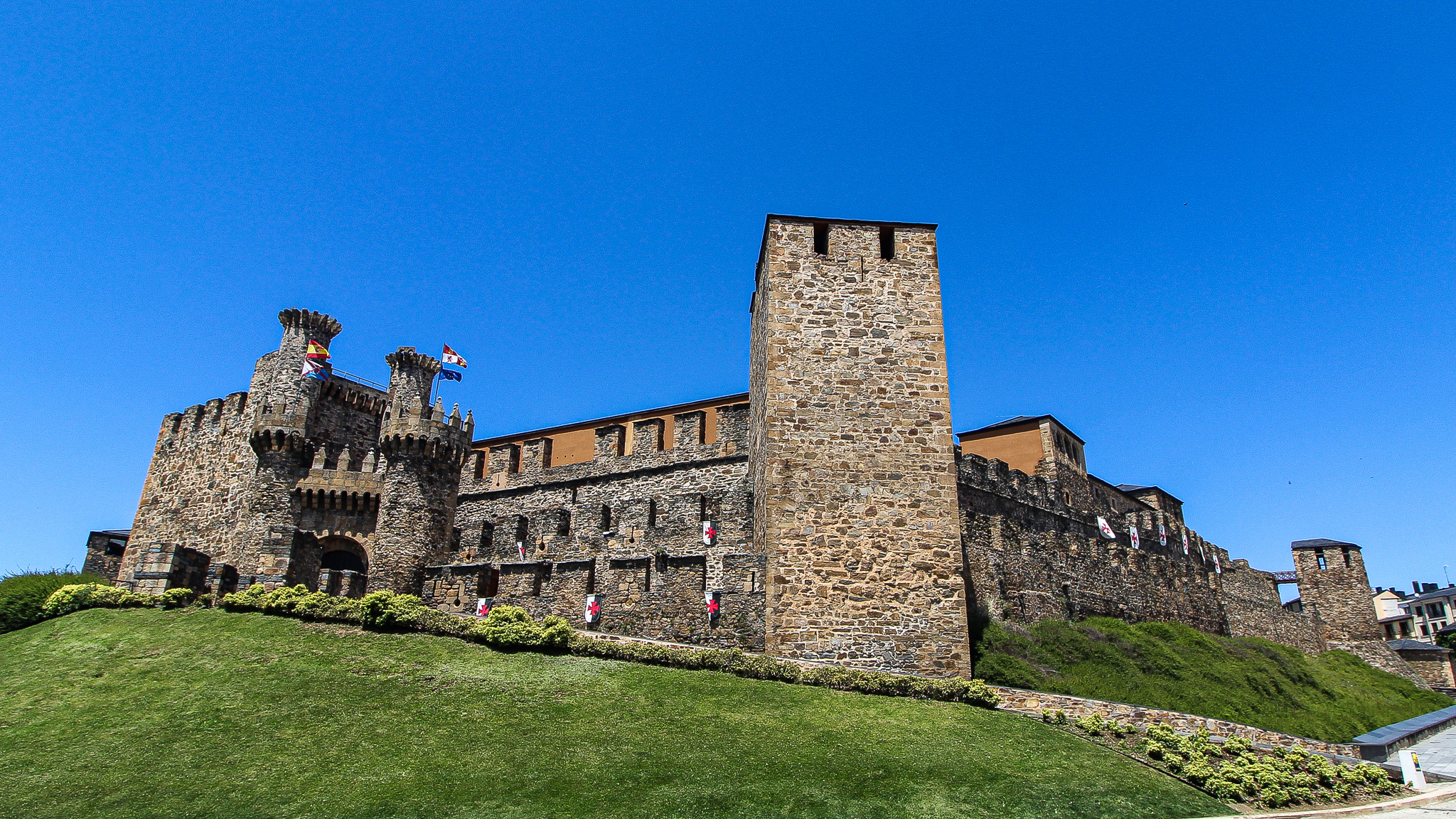We took the A6 motorway up and through the Montes de Leon, winding our way across a burnt red landscape of Galician granite rock.
It was 32 degrees in the shade and the blinding white light bounced off the deep rusty hues and dark greys of the jagged rock face, which the wide and fast ‘autovia’ had been carved through. Not for the first time we commented admiringly of the engineering of the national highway network.

Descending into Ponferrada via a seemingly endless sequence of roundabouts, feeding in the local mountain roads, we found free parking for ‘autocaravanas’ with a view of the surrounding peaks.
The narrow, arcaded streets of the small town gave welcome shade and a semblance of feeling cool. Ponferrada is renowned for its magnificent medieval castle of the Knights Templar.
Built in the 12th century at the edge of the town which subsequently grew up behind it and overlooking the green River Sil, it’s a walled fortress that guarded this point on the Camino de Santiago de Compostela.

The knights’ purpose was to protect the pilgrims making the arduous climb through the mountains to cross the Sil. We weren’t sure what the pilgrims needed protection from.
Clearly, there’s less poverty in pilgrimage these days, but presumably most of those trekking to pay homage to the relics of Saint James didn’t have much more than the clothes on their backs and a few pennies for bed and board. It was intriguing.

The town’s other attraction is the unique Luis del Olmo Radio Museum, which one of us was especially keen to visit. Our man in the museum writes:
Waving my BBC ID card, my visit began with a rehearsed introduction, “Hola, trabajo en radio en la BBC en inglaterra”. Radio anoraks everywhere love to know these things and the two ladies behind reception left their seats and came to shake my hand with enthusiasm.
The questions then came thick and fast: “Cuanto tiempo? A qué te dedicas? Que ciudad? En que estacion”. Thankfully I’d also rehearsed, in Spanish, a bit more information about my career which seemed to satisfy them. I tried paying the entrance fee but they wouldn’t hear of it. Undeserving, for the next hour, I was treated like radio royalty.

The museum owes its name to one of the greatest Spanish radio communicators, Luis del Olmo, a native of Ponferrada and pioneer of talk radio. Inside an old Baroque-style manor house, in the heart of the old town, is one of the most complete collections of radio receivers in Europe.
More than 200 devices have been donated by Luis del Olmo, with a few additions from the best European and North American manufacturers.
One room was like an engineer’s workshop, with parts, wires and old ends of tape, ready for splicing. I recognised clunky equipment from when I started 28 years ago – and was drooling over radio sets, now almost 100 years old.

It was a terrific journey through the history of radio, and as I left, I felt quite nostalgic about all the old gear. At a time when I’m at risk of redundancy because the BBC wants to push digital services in favour of radio, the irony that the equipment I’d been trained on was now in a museum, wasn’t lost on me.
The twisty drive along the Rio Sil to Monforte de Lemos turned out to be the most adventurous of the trip so far. The smoothly tarmacked N-120 wound its way higher and higher taking us up once again into the Montes de Leon.

We passed cavernous stone quarries and joined a convoy of haulage trucks heaving heavy loads of stone and granite ever upwards. In the opposite lane long trailers of freshly felled forestry was being taken down the mountainside for logging.
At river level, the road crossed the curving banks several times on wide stone bridges. We followed one of its tributaries, Rio Cabe, to the Roman founded town of Monforte de Lemos.
Over coffee in the pretty central square and waiting for a tapas of albondigas (meatballs) which never arrived, the Spanish accents of chattering locals were noticeably thicker. Some conversation we couldn’t work out at all. We had arrived in Galicia, where the native Galego language is spoken fluently by more than half of Galicians.

Fortified on caffeine ahead of a notoriously twisty hair pin stretch of road, we passed into the beautiful Sil Canyon, a deep gorge of vertical walls of rock and forestry rising to five hundred meters along 35kms of waterway.
Dotted along the canyon’s steep slopes are vineyards established by Romans which later became the mainstay of monasteries, producing high quality wines from the gradient and microclimate of the gorge.

At a lookout above the river, the air smelt thickly of pine and pulsed with the sawing of cicadas. Bees and butterflies bounced about on wildflowers. We were in Green Spain.
Equally impressive but undoubtedly more queasy making is the San Esteban reservoir at the confluence of the Sil with the Rio Mino. Without warning and in a winding descent the road suddenly spun us alongside its mighty concrete dam.
At its completion in 1957, it was Spain’s largest hydraulic engineering works.

At 120 meters tall, 150,000 tonnes of cement and 10,000 tonnes of steel hold back the powerful flow of the Mino.
It was unnatural, unnerving and ultimately stomach churning. Gratefully leaving it behind in the driver’s wing mirror, it was with some relief that we felt the road flatten out and straighten up along the wide stretch of the Mino around Ourense and onward to Ribadavia.











